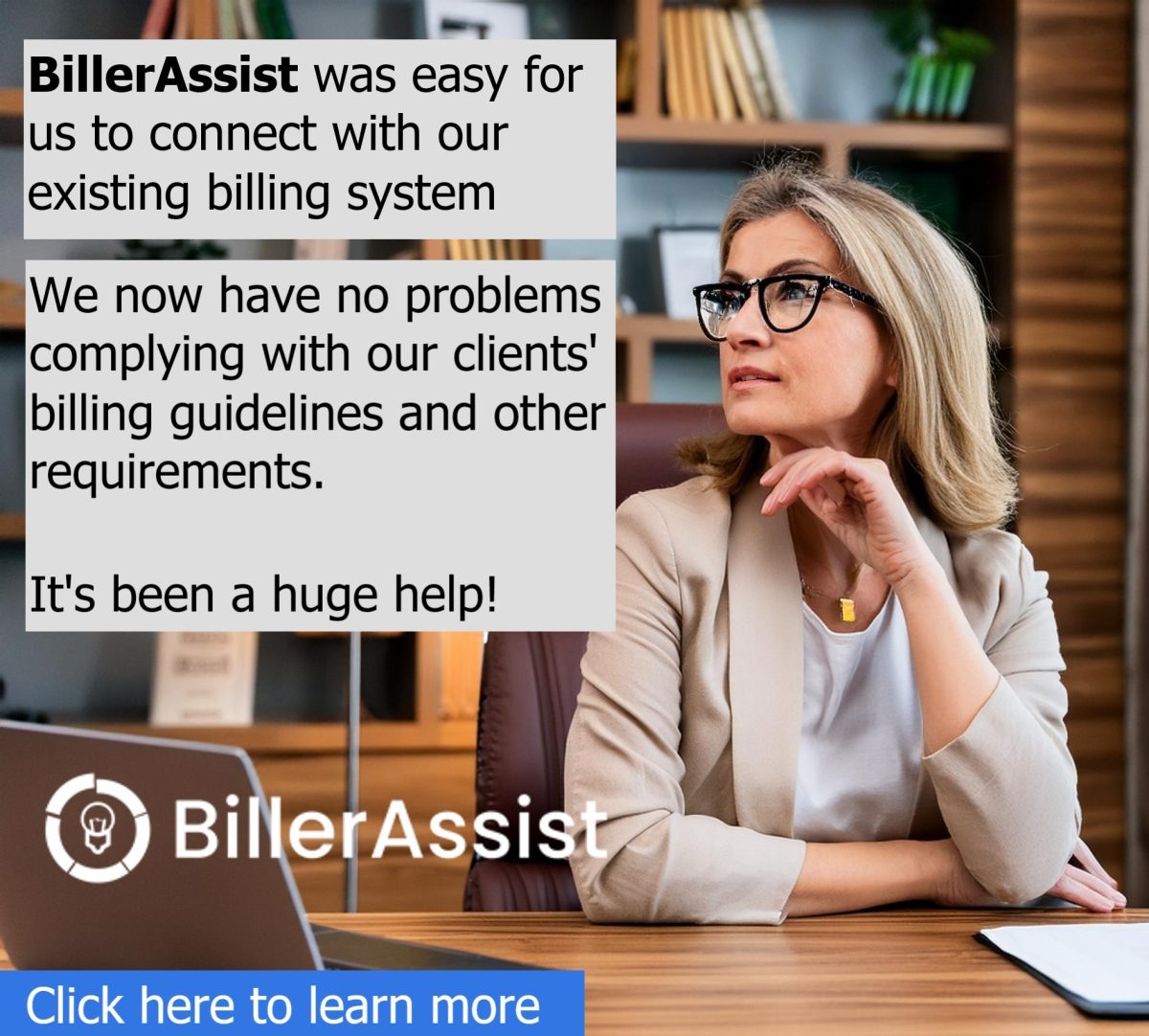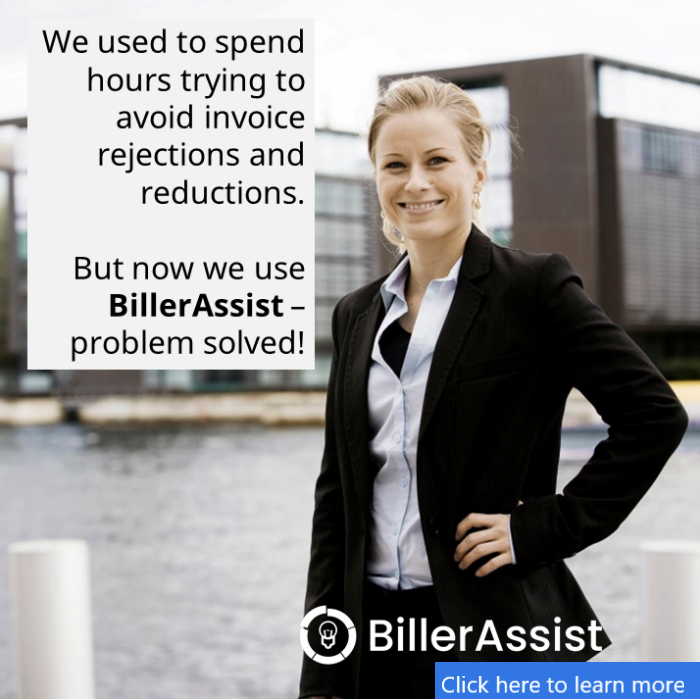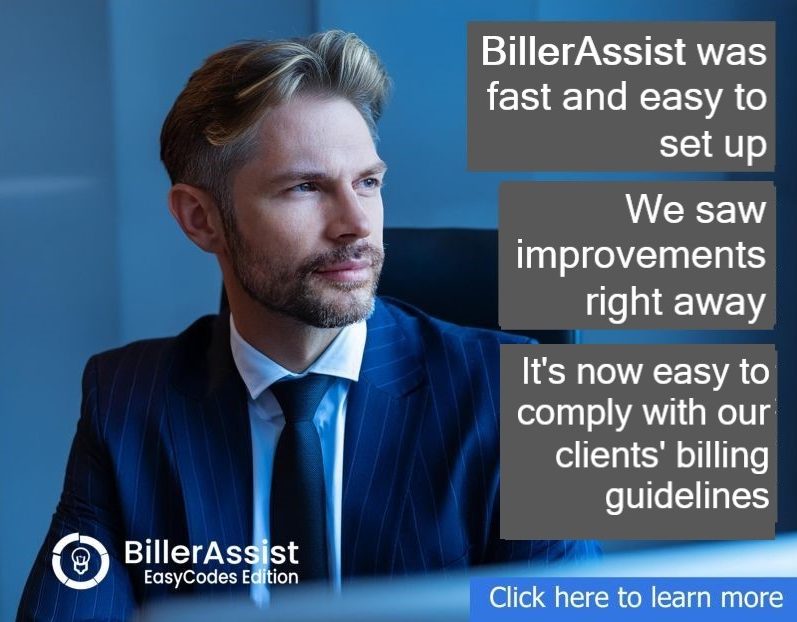How to Use Data to Make Your Law Business Better
Innovative solutions for AI-powered legal bill review have arrived to drive revenue increases for law firms while also controlling costs for clients.
Although seemingly at odds, data-driven legal billing applications can achieve both higher profits for law firms and greater cost savings for clients through drastic improvements in efficiency.
A recent Georgetown Law report highlighted the challenges in attempting to boost growth and law firm productivity.
According to the report, although most of the many law firms participating in the survey increased billing rates at different levels, “clients continued to push back on rate increases, keeping pressure on the realization rates that firms were able to achieve”.
This continuing trend demonstrates the ongoing problem of achieving profit increases solely through billing rate increases – that is, raising the hourly rate does little good, if the client pays fewer of the hours billed.
As a result, data-driven solutions are becoming a beacon within the legal profession. The reason is that data-driven solutions allow firms to gain real-time insights in order to make better business decisions and improve their bottom line, without simply raising hourly rates. Nevertheless, a recent Industry Outlook report by Major, Lindsey & Africa finds that as law firms expand their use of various solutions, they often miss an opportunity to optimize profits by evaluating their own billing practices to increase profits and productivity.
This article explores how organizing billing data into a standardized system like the Uniformed Task-Based Management System (UTBMS) allows law firms and clients alike to improve their financial performance.
A Brief History of UTBMS Codes and LEDES Invoices
Since their introduction more than 20 years ago, the utilization of Uniformed Task-Based Management System (UTBMS) billing codes have allowed both clients and law firms to track and compare specific legal services and expenses and map these data points to particular outcomes.
For those who might not be familiar, UTBMS codes classify legal services and expenses performed by a law firm or other vendor.
UTBMS creates categories of specific legal tasks and expenses and assigns specific codes to such task and expense services. Associating these codes to time and expenses entries in invoices shows clients exactly where and how lawyers are providing legal services. This, in turn, allows for greater data analysis, reporting, and fact-based decision-making.
The increasing prevalence of UTBMS codes arose from corporate legal departments that were purchasing large quantities of legal services looking to closely monitor invoices and services from outside counsel and vendors. Imagine trying to make sense of legal spending bills that included only a vague description of services by multiple timekeepers in a single day, or evaluating multiple paragraphs or pages of task descriptions.
In a joint effort to bring more transparency to this issue, the American Bar Association, the Association of Corporate Counsel, and PricewaterhouseCoopers came together to create a unified task-based billing standard known as UTBMS.
The goal of UTBMS coding was to create advanced metrics for clients and law firms to achieve accurate internal measures of profitability and productivity, as well as to increase transparency for all parties involved.
Such measures enabled clients and law firms to capture meaningful billing information and data into an easier and more digestible way to analyze legal services.
International In-house Counsel Journal states that “a process that provides for actionable information from that data is central to being able to manage a legal department strategically and with greater efficiency.”
This is the reason why the UTBMS categorization method is critical when looking at process improvements.
Without utilizing the UTBMS categorization method, it is difficult to accurately assess legal spending or to develop useful insights that rationalize outside counsel retention or legal spending decisions.
Running the risk of making significant decisions based on inaccurate or misleading data can be devastating, but uniformly applied data standards make for more carefully informed decisions based on empirical evidence.
Whereas UTBMS billing codes categorize legal work and expenses, the Legal Electronic Data Exchange Standard (LEDES) provides uniform data formats to submit UTBMS-coded invoices.
After creating UTBMS billing code standards, the joint group began to create a standard format for the exchange of billing information known as the LEDES Oversight Committee (LOC). The LOC is “an international, voluntary, not-for-profit organization comprised of legal industry representatives and is charged with creating and maintaining open standard formats for the electronic exchange of billing and other information between corporations and law firms.”
The LOC is dedicated to use open standards to uniformly satisfy the needs of the legal sector with five main principles:
- Keep it simple;
- Make it unambiguous;
- Diverge from existing formats only if absolutely necessary;
- Only ask for information the law firm is typically able to provide from their financial systems; and
- Meet the needs of corporations, law firms, and legal industry software vendors to the maximum extent possible consistent with the first four criteria.
Using the LEDES standard formats, receiving systems can electronically assemble billing tasks and expenses into more easily comprehensible formats for greater ease of review and speed of payment.
The utilization of UTBMS billing codes in standardized LEDES invoicing formats helps both clients and law firms to track and compare specific legal services and expenses, which then map specific data points to insightful information. In other words, UTBMS codes allow “Moneyball” kinds of analyses for law firms and clients.
Billing data is readily available
Law firms and legal departments are using their existing data to predict outcomes.
Annie Dike from Bulls Eye’s Expert Legal News noted that “legal analytics seems to take this to the next step by mining data in case dockets and filings, and then aggregating the data to reveal trends and patterns in past litigation that can be used to inform legal strategy.”
Similarly, Case Crunch’s lawyer challenge uncovered the potential of predictive analytical tools.
The Case Crunch challenge pitted over 100 commercial lawyers against its computer program. Both humans and the computer system were given the basic facts of hundreds of lawsuits in an attempt to determine whether the lawyers or the computer soft- ware could better predict results.
Of the 775 prediction submissions, the computer was the clear victor with an accuracy rate of 86.6 percent, compared with 66.3 percent for the lawyers.
Moreover, in a Legal Talk Network podcast, Lex Machina’s Josh Becker explained the importance of data in the legal field as follows:
“It’s using data to demonstrate your expertise and to compete now on data, not just on reputation or relationships maybe from the past, but to compete on data to showcase your expertise. And secondly, after winning business is winning cases. So, using data to determine the best strategy in front of a judge, to size up your opposition, to under- stand how long it’s going to take to do your budgeting, all that is part of winning cases.”
But data regarding the likelihood of certain reactions to specific arguments and testimony, myriad nuances of contract negotiations, and other aspects of legal work can be hard to quantify and use. Instead, Ed Finkel of the Illinois Bar Journal asks:
“When it comes to optimizing your practice, do you trust your gut? Don’t. If you aren’t using data to measure what works and what doesn’t, you can’t be sure you’re winning the game. The good news: your practice generates the data you need to gauge success and adjust as needed.”
By organizing and categorizing billing data with UTBMS codes, billing data can now improve common profitability metrics such as revenues, profits, realization rates, and collection rates – all directly from a law firm’s own systems.
Combining machine learning and AI with historical billing and collections data can be used to improve performance in real time and prevent non-billable and unbillable work.
Moreover, tying billing data to underlying work product allows hyper-accurate budget projections, staffing need projections, timelines, and the like. This relieves firms and their clients to better optimize how to plan, budget, and staff similar and new matters.
Data-driven billing at law firms
Clio’s “Legal Trends Report” finds that small to mid-sized law firms collect only one-and-a-half hours of daily time, thereby losing six hours or more of daily work.
Similarly, a recent Georgetown Law report concluded that, on average, “law firms are collecting only 83.5 cents for every $1.00 of standard time they record”. Interestingly, the report notes, these multi-year collection rate numbers continued to decline even as the economy was improving from the depths of the 2008 financial meltdown.
Such losses are attributable not only to clients not paying their bills but also to time consumed by non-billable tasks such as billing review.
Implementing data-driven solutions that shorten the time needed to generate compliant invoices that are more likely to be paid is often easy to do, because these solutions utilize the law firm’s own billing records. Speeding up the invoicing process is also often the most effective way to drive increased profits per partner.
It is axiomatic that the faster a law firm can generate accurate and compliant bills, the faster the bills can be submitted for payment. Then, at least theoretically, submitting bills to clients faster should mean faster payments and improved cash flow and profitability.
The Un-Billable Hour, a law practice and advisory podcast, recommends optimizing law firm revenue by asking how many days it takes to produce a bill along with the number of days it takes to get paid. This can be done by determining a law firm’s DSO, a metric often used in the product merchandising industry.
Days Sales Outstanding (DSO) measures the average number of days it takes a company to collect payments after sales are made. The lower the DSO, the faster a company profits from its sales, which in turn ultimately indicates how long a firm’s profits will remain within current cash flow.
The following simplified formula is demonstrative of how to calculate a law firm’s DSO:
(Accounts Receivable / Total Revenue) x Number of Days
As the formula indicates, lower DSO values are good, higher DSO values are bad. Decreasing the number of days required to produce invoices decreases DSO.
Similarly, increasing collection rates results in higher total revenue, and also reduces DSO.
Lawyers are all too familiar with the rush to get bills out every month. But they cannot ethically simply submit unreviewed time and expense entries to clients for payment.
Attorneys are required to conduct reasonable client billing. For example, for American lawyers, “Rule 1.5 of the ABA Model Rules of Professional Conduct prohibits fees that are ‘unreasonable’.”
In fact, the Supreme Court of the United States has held that attorneys must exercise “billing judgment”, and “make a good-faith effort” to exclude charges and expenses “that are excessive, redundant, or otherwise unnecessary”.
Therefore, lawyers are ethically bound to review and clean up their bills before submitting them to clients for payment.
The challenges of billing entry and billing review, both of which are required to submit bills for payment, increase a law firm’s DSO.
According to The Un-Billable Hour, attorneys often lose money due to inefficiencies such as “disorganization, slow response to clients, late billing invoices and not tracking time”, which result in low productivity and low revenue.
In this vein, legal bill review is also a significant factor driving inefficiency, despite the various billing and time tracking applications to ease the burden of time entry and bills submission.
The time-consuming process of reviewing bills for submission often goes unaddressed even though it is a significant bottleneck in the bill submission process.
One of the best strategies to increase law firm profitability begins by adopting data-driven solutions to drastically decrease the time needed to review bills for submission to clients.
Data-driven billing at clients
The myriad responsibilities and pressures of in-house counsel are pushing company legal departments to find the best ways to increase efficiency and productivity.
Some of the most prominent means of doing so are data-driven solutions to improve transparency with regard to outside counsel billing and other legal expenditures.
Technology is not a panacea. Adam Beschloss and Steven Rudnick of Inside Counsel suggest:
“While technology is requisite as an enabler for managing legal invoices, effective control rests on the creation of robust billing guide- lines and accurate data collection… factors like the development of robust billing guidelines, the strict use of UTBMS codes, and the subsequent review of every line item of every invoice for conformance to your billing guidelines are prerequisite.”
The American Bar Association (ABA) recommends a checklist to consider when analyzing outside counsel billing.
The ABA checklist factors for outside counsel to consider in controlling their legal expenditures include:
- Hiring the right outside counsel;
- Set outside counsel guidelines;
- Implement legal project management;
- Insource and outsource legal work;
- Analyze matter outcome; ad
- Terminate underperforming outside counsel.
Companies utilizing these baseline factors are able to develop more meaningful metrics to enhance their strategic planning and collaboration efforts with outside counsel.
Once these prerequisites are in place, the next step is researching the marketplace to find the most appropriate and valuable applications. With the rise of AI and machine learning technologies, companies are taking advantage of the opportunity to automatically standardize time and expense entries using their existing legal matter management and systems.
By using billing automation, in-house counsel gain the advantage of receiving standardized data from their partner law firms. In-house legal departments can now easily compare billing data from one firm to another, with accuracy and reliability never made available before.
For example, Thomson Reuters’ “Latest Trends and Best Practices in Managing Outside Counsel” report details how automation reduces billing disagreements from standardizing the determination of exactly where invoices are out of compliance. The report further indicates that automated legal billing significantly expedites the legal billing review process, resulting in shorter review periods, controlled legal expenditures, results- and value-based decision-making, and other goals.
As such, AI and machine learning technologies are crucial to providing the capacity to drastically improve efficiency and transparency in managing outside counsel and maximizing legal expenditures.
Course of action
Law firms and clients alike continue to look for new ways to increase efficiency and to develop better practices. A Deloitte report on legal billing and predictive coding claims:
“Current technology advances are providing opportunities to better measure, manage and optimize legal spend, even while leveraging conventional management tools… These advancements are expected to enhance management activities for both corporate law departments and law firms, and potentially allow the promise of activity-based management for legal activities to become better realized.”
Implementing the UTBMS/LEDES standards is one method to advance these goals.
For clients, applications like Thompson Reuters’ Legal Tracker (Serengeti), Onit’s Aptitude, LexisNexis’ CounselLink, and Wolters Kluwer’s TyMetrix 360° all offer efficient means of receiving bills from outside counsel, tracking invoices and payments, and conducting internal data analysis using UTBMS codes and standardized LEDES invoicing.
Similarly, there are various applications available to help law firms accomplish their UTBMS coding and LEDES invoice formatting needs. For example, Clio, Rocket Matter, Practice Panther, Timeslips, MyCase, and LeanLaw, along with other legal billing software and practice management systems, permit lawyers to add UTBMS codes and create invoices in LEDES formats. In most cases, these apps require users to select and apply appropriate UTBMS codes to time and expense entries from pull-down menus.
However, inaccurate UTBMS coding, frequent use of default or catch-all codes, and random or non-uniform application of billing codes can negatively impact valuable data analysis and reporting.
When billing codes do not accurately reflect services or expenses entries, the billing codes become essentially meaningless. Applications such as Effortless EasyCodes eliminate the manual coding entirely by automating the application of codes to billing entries. Automating the process makes UTBMS codes more valuable through uniformity in code application.
Conclusion
The number of data-driven applications in the legal field is growing at a remarkable pace.
With so many options, law firms and clients must carefully determine the applications that provide the most value to their specific needs.
The value of standardized and categorized billing data should not be overlooked. The UTBMS and LEDES standards, among others, provide valuable insight for both companies and law firms to improve their business.
The data needed is readily available in any billing system, and automation tools are now available to make its use and analysis even easier. Utilizing the available technology will put law firms at the forefront because of the greater transparency in both their billing and their internal metrics.
In addition, clients will be able to manage their costs more effectively and obtain more efficient outcomes based on legal spend.











